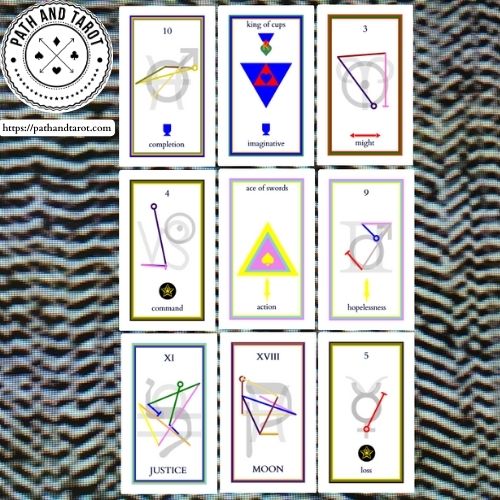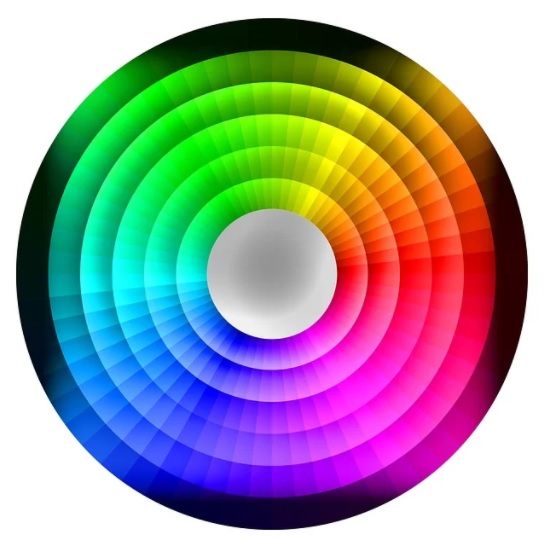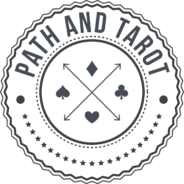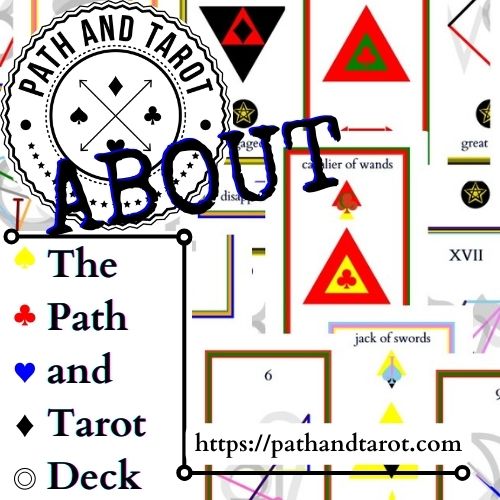About the Path and Tarot Deck:
The Path and Tarot deck is a unique creation that is rooted in the magical teachings of the Golden Dawn. To make this tarot deck I had to consider a handful of primary resources and make many artistic considerations.
The Golden Dawn teachings alone provide the knowledge to create a tarot deck. All the magical symbols and structure are contained in the Golden Dawn teachings. I gained a foundational understanding of the Golden Dawn model of the tarot and created my own version of it.
About the Golden Dawn
The Golden Dawn was a magical society that existed between the late 19th and early 20th centuries. Aspiring magicians would be tasked with creating their own tarot decks to become initiated into the society. I asked myself how would a magician create a tarot deck? What would be the easiest and most effective way to do it?
My answer was to create a tarot deck devised of only symbols using no illustrations.
Note: Initiates of the Golden Dawn were usually given a tarot deck to copy by hand. They did not have to devise their own Tarot design from scratch.
The Symbols of the Tarot
The Golden Dawn’s tarot system consists of symbols from the seven old planets, the twelve zodiac signs, the five elements, and an ancient alphabet of twenty-two characters. There also exists a matrix of colour associations for each of the symbols.
The twenty-two-character Hebrew alphabet is the backbone for which the major arcana (trumps) is ordered. The planets, zodiac, and elemental symbols have their associations to each of the trumps.

The minor arcana is divided into four suits based on the elements fire (wands), air (swords), water (cups), and earth (pentacles). Each number card has a zodiac and a planetary symbol associated with it. These are known as the decans of the zodiac. The decanates of the tarot are described as the zodiac split up into degrees with a different planetary energy ruling section.1
Aces and court cards are a different class in the Path and Tarot deck. The aces are purely the result of the western element they represent, and the court cards of each suit are sub-elements. The court cards contain one of the four elements within each level of the court. This sub-elemental system represents the layers of one’s persona.
Design Scheme
The primary design scheme of the Path and Tarot deck is superimposition. Symbols are placed on top of one another. To finalize the design scheme I added another layer to the tarot cards using sigils.
The Golden Dawn teaches magic squares. These magic squares represent each of the old seven planets. With a magic square, one can create a geometric pattern known as a sigil. An intention written out can be translated into numbers using numerology. The numbers can then be mapped over the planet’s magic square to create the sigil.
The sigil acts as a visual representation of the original intention. The magical power of the planets square can help empower the intention. The sigil is able to work on deeper levels of the mind to help the magician realize their intentions.
The subordinate design scheme of the tarot deck uses a matrix of colour patterns from the Golden Dawn’s system of magic. Each planetary, zodiac, and elemental association has a colour scheme. When working with the Golden Dawn’s colour systems you can uncover a divine matrix of colour associations for each of the tarot cards.2

How It Was Made
I had to make many artistic considerations to create this tarot deck. By trade and education, I am a musician and composer, not a graphic artist. My biggest struggle was to create a tarot deck that could be visually stimulating while using simple digital art methods.
My answer was utilizing pre-made design elements in Canva, a free web application. Using Canva I entered the tarot card template from Make Playing cards. This set the exact dimensions ready for print. Then I worked within the dimensions to create the cards using pre-existing elements within Canva.
The Golden Dawn colour system is fundamentally a colour wheel. Each colour has what the Golden Dawn calls a flashing colour.3 The flashing colour is the opposite end of the colour wheel for a chosen colour. From yellow you have violet, and orange you have blue, and so on. These flashing colour’s act as the colour scheme for all of the tarot cards.

I mapped out all the possible colour associations for each tarot card and used them in creative ways to colour the borders and sigils. Each number card has the suit’s colour scheme embedded into its borders. The court cards all have the same colour scheme as the number cards but the primary colour is inverted. The trump cards cards had more colours than there were layers in the border. I added additional lines into the layers to compensate.
With the borders in place and each colour association established, I added the symbols onto the cards. I made the zodiac, planetary, Hebrew, and elemental symbols transparent. This is so they can blend when they are superimposed. I would then place a sigil over top of the designs to finalize the card.
To make the sigils I created copies of the Golden Dawn magic planetary squares. The sigil is created by converting a phrase into numbers using numerology. The numbers are then mapped out on the magic square. I gave each numeric connection a different colour from the card’s colour associations.
The court cards and aces are a simple design. They are the western elements using upright and upside-down triangles. Within the elemental triangles, I embedded the playing card symbols. I chose to incorporate the playing card suits to honor the tarot as a trick-taking game.
Spades are swords, clubs are wands, hearts are cups, and diamonds are pentacles. Each playing card symbol is found within the aces, the number cards, and the court cards.
I wanted playing card symbols a part of the tarot deck so that the cards could potentially interface with a playing card deck. When you know the associations of the playing cards, any regular fifty-two-card playing deck can empower a tarot reading. You can match up the elemental dignities, create literal matches with the number cards, and of course create different messages that come from the playing cards themselves. A complete list of playing card meanings is available here.
The final work of the tarot deck was creating a new set of meanings for the aces, the number cards, and the court cards. I took time to consider the Golden Dawn’s meaning for each of the cards. Using the dictionary I uncovered deeper meanings and considered their synonyms. Through this unpacking, I finalized the re-wording of the minor arcana.
The back design follows the primary design method of superimposition. I wanted the design to have a feeling of uncertainty, chaos, and noise. The tarot cards when revealed create a resolution to that noise.
How to Use the Tarot Cards
The Path and Tarot deck is void of any illustrations. It forces the user to work with only symbols. Despite this potential difficulty, the deck is usable for anyone at any skill level. Each ace, number card, and court card have a word association written on it. These are the keywords for each card and can be relied on to create your tarot message. Very quickly one can piece together these keywords and draw up a fine message.
The major arcana cards still rely on memorization. They have no discernible keywords like the other cards. The user must know what each card is. Fortunately, with a little learning, a new user will easily be able to understand the meaning of the trumps.
A trick to memorize the trumps is learning the hero’s journey. The major arcana is a repeating cycle from Fool to Universe (World), and the cycle follows the structure of the hero’s journey. Memorizing the major arcana set is much easier when you see it as a journey. Of course, you can use my web guide to learn about each card.
Using the Path and Tarot deck is relatively easy when you are able to improvise with a handful of keywords. You can explore one word and unpack its meaning to connect it with others. In this way, the deck can be considered a trainer deck to understand reading fundamentals and the pure symbolism behind the cards.
Using only the fundamentals will help the reader work from a place of repeated memorization and improvisation. The end result will allow the reader to adapt to other tarot decks with ease.
The tarot cards should be used in a matrix of at least nine cards in a three by three square. This is so that you can visually see the colours as a whole. The colours help your subconscious devise a deeper connection with each of the cards. You will begin to see that cards share colours, and thus share connections and meaning. Let your eyes soften and meditate on the colours. You will begin to see the cards in new ways.
Here is a card spread that you can use to get started. Enjoy the path -Brent.
Learn how to use the deck from this video demo.
Use the Path and Tarot web guide to learn about each card.
Reference Links
https://en.wikipedia.org/wiki/Hero’s_journey
https://en.wikipedia.org/wiki/Tarot_card_games
https://en.wikipedia.org/wiki/Hermetic_Order_of_the_Golden_Dawn
https://en.wikipedia.org/wiki/Magic_square
https://en.wikipedia.org/wiki/Sigil
https://en.wikipedia.org/wiki/Color_wheel
Notes
1. Cicero Chic and Sandra Tabatha Cicero, Golden Dawn Magic: A Complete Guide to the High Magical Arts (Woodbury, Minnesota: Llewellyn Publications), 167.
2. Ibid., 73-99.
3.Ibid., 52.
Bibliography
Centre of Excellence. (2020). Advanced Tarot Diploma. https://www.centreofexcellence.com/shop/advanced-tarot-diploma-course/
Cicero, Chic, and Sandra Tabatha Cicero. Golden Dawn Magic: A Complete Guide to the High Magical Arts. Woodbury, Minnesota: Llewellyn Publications, 2019.
Cicero, Chic, and Sandra Tabatha Cicero. Golden Dawn Ritual Tarot: Keys to the Rituals. Symbolism, Magic & Divination. Woodbury, Minnesota: Llewellyn Publications, 1991.
Eden Gray. A Complete Guide To The Tarot. United States of America :Bantam Books, 1970.
Kenner, Corrine. Tarot for Writers. Woodbury, Minnesota: Llewellyn Publications, 2007.
Monte Faber. Karma Cards Guidebook.New York: Sterling Ethos, 1988.
As an Amazon Associate I earn from qualifying purchase. Know that any gains are reinvested into this website. The end result is that you are supporting the creation of quality content.



Pingback: The Path and Tarot Web Guide | PathandTarot
Pingback: Buy the Path and Tarot Deck | PathandTarot
Pingback: The Path and Tarot Card Spread | PathandTarot
Pingback: Playing Card Meanings For Cartomancy | PathandTarot